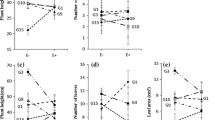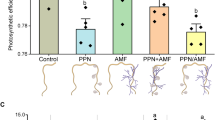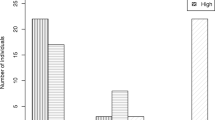Abstract
In Arctic tundra, plant pathogens have substantial effects on the growth and survival of hosts, and impacts on the carbon balance at the scale of ecological systems. To understand these effects on carbon dynamics across different scales including plant organ, individual, population and ecosystem, we focused on two primary factors: host productivity reduction and carbon consumption by the pathogen. We measured the effect of the pathogen on photosynthetic and respiratory activity in the host. We also measured respiration and the amount of carbon in the pathogen. We constructed a model based on these two factors, and calculated pathogenic effects on the carbon balance at different organismal and ecological scales. We found that carbon was reduced in infected leaves by 118% compared with healthy leaves; the major factor causing this loss was pathogenic carbon consumption. The carbon balance at the population and ecosystem levels decreased by 35% and 20%, respectively, at an infection rate of 30%. This case study provides the first evidence that a host plant can lose more carbon through pathogenic carbon consumption than through a reduction in productivity. Such a pathogenic effect could greatly change ecosystem carbon cycling without decreasing annual productivity.







Similar content being viewed by others
References
ACIA (2004) Impacts of a warming arctic: arctic climate impact assessment. Cambridge University, Cambridge
Alexander HM (2010) Disease in natural plant populations, communities, and ecosystems: insights into ecological and evolutionary processes. Plant Dis 94:492–503
Bagchi R, Gallery RE, Gripenberg S, Gurr SJ, Narayan L, Addis CE, Freckleton RP, Lewis OT (2014) Pathogens and insect herbivores drive rainforest plant diversity and composition. Nature 506:85–88
Berger S, Papadopoulos M, Schreiber U, Kaiser W, Roitsch T (2004) Complex regulation of gene expression, photosynthesis and sugar levels by pathogen infection in tomato. Physiol Plant 122:419–428
Cannon PF, Minter DW (1986) The Rhytismataceae of the Indian subcontinent. Mycol Pap 155:1–123
CAVM-Team (2003) Circumpolar Arctic Vegetation Map. Scale 1: 7500,000. Conservation of Arctic Flora and Fauna (CAFF) Map No.1. US Fish and Wildlife Service, Anchorage
Chou HM, Bundock N, Rolfe SA, Scholes JD (2000) Infection of Arabidopsis thaliana leaves with Albugo candida (white blister rust) causes a reprogramming of host metabolism. Mol Plant Pathol 1:99–113
Harvell CD, Mitchell CE, Ward JR, Altizer S, Dobson AP, Ostfeld RS, Samuel MD (2002) Climate warming and disease risks for terrestrial and marine biota. Science 296:2158–2163
Heil M, Bostock MR (2002) Induced systemic resistance (ISR) against pathogens in the context of induced plant defences. Ann Bot 89:503–512
IPCC (2013) Stocker TF, Qin D, Plattner GK, Tignor M, Allen SK, Boschung J, Nauels A, Xia Y, Bex V, Midgley PM, eds. Climate Change 2013: the physical science basis. Contribution of Working Group I to the Fifth Assessment Report of the intergovernmental panel on climate change. Cambridge University Press, Cambridge
Karsten PA (1872) Fungi in insulis Spitsbergen et Beeren Eiland collecti. Examinat, enumerate. Öfvers K Vet-Akd Förth 2:91–108
Mangan SA, Schnitzer SA, Herre EA, Mack KML, Valencia MC, Sanchez EI, Bever JD (2010) Negative plant-soil feedback predicts tree-species relative abundance in a tropical forest. Nature 466:752–755
Manter DK, Bond BJ, Kavanagh KL, Rosso PH, Filip GM (2000) Pseudothecia of Swiss needle cast fungus Phaeocryptopus gaeumannii physically block stomata of Douglas-fir, reducing CO2 assimilation. New Phytol 14:481–491
Manter DK, Bond BJ, Kavanagh KL, Stone JK, Filip GM (2003) Modeling the impacts of the foliar pathogen, Phaeocryptopus gaeumannii, on Douglas-fir physiology: net canopy carbon assimilation, needle abscission and growth. Ecol Model 154:211–226
Masumoto S, Tojo M, Uchida M, Imura S (2014) Rhytisma polaris: morphological and molecular characterization of a new species from Spitsbergen Island, Norway. Mycol Prog 13:181–188
Meltofte H (ed) (2013) Arctic biodiversity assessment. Status and trends in Arctic biodiversity. Conservation of Arctic Flora and Fauna, Akureyri
Mordecai EA (2011) Pathogen impacts on plant communities: unifying theory, concepts, and empirical work. Ecol Monogr 81:429–441
Muraoka H, Uchida M, Mishio M, Nakatsubo T, Kanda H, Koizumi H (2002) Leaf photosynthetic characteristics and net primary production of the polar willow (Salix polaris) in a High Arctic polar semi-desert, Ny-Ålesund, Svalbard. Can J Bot 80:1193–1202
Muraoka H, Noda H, Uchida M, Ohtsuka T, Koizumi H, Nakatsubo T (2008) Photosynthetic characteristics and biomass distribution of the dominant vascular plant species in a High-Arctic tundra ecosystem, Ny-Ålesund, Svalbard: implications to their role in ecosystem carbon gain. J Plant Res 121:137–145
Nakatsubo T, Bekku Y, Kume A, Koizumi H (1998) Respiration of the belowground parts of vascular plants: its contribution to total soil respiration on a successional glacier foreland in Ny-Ålesund, Svalbard. Polar Res 17:53–59
Nakatsubo T, Bekku YS, Uchida M, Muraoka H, Kume A, Ohtsuka T, Masuzawa T, Kanda H, Koizumi H (2005) Ecosystem development and carbon cycle on a glacier foreland in the high Arctic, Ny-Ålesund, Svalbard. J Plant Res 118:173–179
Nakatsubo T, Fujiyoshi M, Yoshitake S, Koizumi H, Uchida M (2010) Colonization of the polar willow Salix polaris on the early stage of succession after glacier retreat in the High Arctic, Ny-Ålesund, Svalbard. Polar Res 29:385–390
Nordin A, Strengbom J, Forsum A, Ericson L (2009) Complex biotic interactions drive long-term vegetation change in a nitrogen enriched boreal forest. Ecosystems 12:1204–1211
Ohtsuka T, Adachi M, Uchida M, Nakatsubo T (2006) Relationships between vegetation types and soil properties along a topograph- ical gradient on the northern coast of the Brøgger Peninsula, Svalbard. Polar Biosci 19:63–72
Olofsson J, Ericson L, Torp M, Stark S, Baxter R (2011) Carbon balance of arctic tundra under increased snow cover mediated by a plant pathogen. Nat Clim Change 1:220–223
Rønning OI (1996) Svalbards flora. Polar handbook, 9th edn. Norwegian Polar Institute, Oslo
Roy BA, Gusewell S, Harte J (2004) Response of plant pathogens and herbivores to a warming experiment. Ecology 85:2570–2581
Scholes J, Rolfe SA (1996) Photosynthesis in localized regions of oat leaves infected with crown rust (Puccinia coronata): quantitative imaging of chlorophyll fluorescence. Planta 199:573–582
Scholler M, Schnittler M, Piepenbring M (2003) Species of Anthracoidea (Ustilaginales, Basidiomycota) on Cyperaceae in Arctic Europe. Novia Hedwig 76:415–428
Skarpe C, van der Wal R (2002) Effects of simulated browsing and length of growing season on leaf characteristics and flowering in a deciduous Arctic shrub, Salix polaris. Arct Antarct Alp Res 34:282–286
Smith JA, Blanchette RA, Newcombe G (2004) Molecular and morphological characterization of the willow rust fungus, Melampsora epitea, from arctic and temperate hosts in North America. Mycologia 96:1330–1338
Swarbrick PJ, Schulze-Lefert P, Scholes JD (2006) Metabolic consequences of susceptibility and resistance in barley leaves challenged with powdery mildew. Plant, Cell Environ 29:1061–1076
Thornley JHM (1976) Mathematical models in plant physiology. Academic Press, London
Tojo M, Newsham KK (2012) Snow moulds in polar environments. Fungal Ecology 5:395–402
Tojo M, Nishitani S (2005) The effects of the smut fungus Microbotryum bistortarum on survival and growth of Polygonum viviparum in Svalbard, Norway. Can J Bot 83:1513–1517
Tojo M, Masumoto S, Hoshino T (2013) Phytopathogenic fungi and fungal-like microbes in svalbard. In: Imai R, Yoshida M, Matsumoto N (eds) Plant and microbe adaptations to cold in a changing world. Springer, NewYork, pp 263–284
Uchida M, Muraoka H, Nakatsubo T (2016) Sensitivity analysis of ecosystem CO2 exchange to climate change in High Arctic tundra using an ecological process-based model. Polar Biol 39:251–265
Wiedermann MM, Nordin A, Gunnarsson U, Nilsson MB, Ericson L (2007) Global change shifts vegetation and plant–parasite interactions in a boreal mire. Ecology 88:454–464
Acknowledgements
We are grateful to Dr Hiroyuki Muraoka at Gifu University and Dr Yukiko Tanabe at the National Institute of Polar Research for their help with photosynthetic measurements and model estimations. This work was supported by The Graduate University for Advanced Studies (SOKENDAI), the National Institute of Polar Research (Project number KP-11), and the Green Network of Excellence (GRENE) Arctic Climate Change Research Project and Arctic Challenge for Sustainability Project (ArCS) provided by the Ministry of Education, Culture, Sports, Science, and Technology, Japan.
Author information
Authors and Affiliations
Contributions
SM and MU conceived and designed the experiments. SM and MU performed the experiments. SM and MU analyzed the data. SM, MU, ASM and SI wrote the manuscript; other authors provided editorial advice.
Corresponding author
Additional information
Communicated by Jennifer Funk.
Electronic supplementary material
Below is the link to the electronic supplementary material.
442_2017_4037_MOESM1_ESM.pptx
Figure S1 Change in rETR maximum values (mean ± SD) with leaf age. There was no significant difference in the daily values between healthy leaves (open circle) and the non-symptomatic parts of infected leaves (closed circle) (PPTX 41 kb)
Rights and permissions
About this article
Cite this article
Masumoto, S., Uchida, M., Tojo, M. et al. The effect of tar spot pathogen on host plant carbon balance and its possible consequences on a tundra ecosystem. Oecologia 186, 843–853 (2018). https://doi.org/10.1007/s00442-017-4037-7
Received:
Accepted:
Published:
Issue Date:
DOI: https://doi.org/10.1007/s00442-017-4037-7




